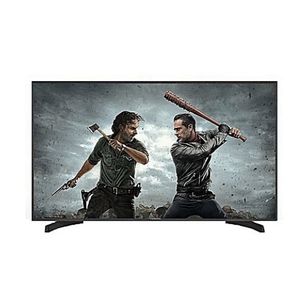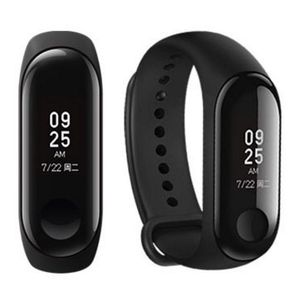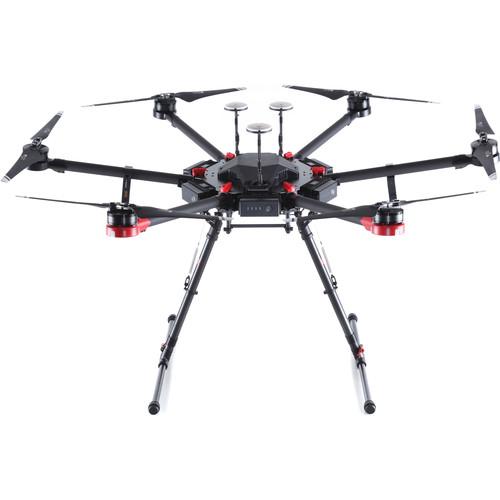

Supporting a total takeoff weight of 34 pounds, the Matrice 600 Pro (M600 Pro) is a hexacopter from DJI designed for professional video and industrial imaging applications. Updated from the original Matrice 600, it features improved flight performance and a higher loading capacity. Pre-installed arms and antennas reduce time required for setup, and the system's modular design makes it easy to mount additional modules.
The Matrice 600 Pro centers around DJI's advanced A3 Pro flight control controller with triple redundancy. It incorporates the Lightbridge 2 system for HD resolution, low-latency monitoring via SDI, HDMI, and USB outputs on the controller. For camera support, the Matrice 600 works with Zenmuse Z15 series gimbals, the Ronin-MX gimbal, and Zenmuse X Series gimbal/camera hybrids.
This version of Matrice 600 Pro comes almost-ready-to-fly (ATF) and includes a controller (transmitter), flight batteries, six-bay charger, flight controller, and sundries. It also features a durable, customizable case that absorbs impact from shakes or falls, providing all-round protection for your hexacopter when carried or transported. Additional hardware needed may include a gimbal, camera, as well as any flight controller add-ons. Some assembly is required.
The Matrice 600 Pro uses sine-wave-driven, intelligent ESCs to ensure it performs accurately, safely, and efficiently, while the A3 Pro flight controller's self-adaptive systems adjust flight parameters automatically based on different payloads.
Updated from the Matrice 600, the Matrice 600 Pro is designed to be simple to set up and ready to fly in a matter of minutes. Its airframe has been optimized for easier transportation with a quick release landing gear design and folding frame arms. Under the new upper cover, the positions of GNSS modules and sensors have been revamped, and a new dampening system for the IMU units increases reliability during flight.
The modular design makes the Matrice 600 Pro easy to set up and ready to use.
All Zenmuse cameras and gimbals are natively compatible, and a maximum payload of 13.2 lb allows it to fly the Ronin-MX gimbal and a range of cameras, from Micro Four Thirds systems to the RED EPIC.
A dust-proof propulsion system simplifies maintenance, while actively cooled motors make for reliable operation for extended periods of time.
The A3 Pro system is optimized for professional and cinematography applications, providing navigation and stabilization to the aircraft. The system features GNSS, which means it can use satellite systems, such as GPS or GLONASS, in combination with a compass to provide precise positional data. The A3 Pro can be used in combination with DJI's Lightbridge 2 system to provide a high-quality video downlink from a gimbal-mounted camera. Ground station software enables features, such as telemetry monitoring and route planning, and provides a flight simulator.
The system features three IMUs and three GNSS units, with additional analytical redundancies for a total of six redundancies. Working together with advanced diagnostic algorithms, if the A3 Pro detects GNSS or IMU unit failure during flight, it seamlessly switches to another unit to maintain reliability and precision.
The Matrice 600 Pro supports the DJI GO app as well as the DJI Assistant 2. Get a live HD view, battery status, redundancy status, transmission strength, and much more straight from the DJI GO app. DJI GO is also the control center for the camera, giving access to shutter speed, ISO, and photo or video capture on any Zenmuse X Series camera as well as remote focus and aperture on the Zenmuse X5 and X5R cameras. The DJI Assistant 2 supports firmware updates and the new Ground Station, and comes with a built-in flight simulator.
The Matrice 600 Pro's radio range extents to 3.1 miles with a clean signal.
The A3 GNSS system can be upgraded with separately available Real-Time Kinematic technology (RTK) for even greater navigational accuracy. Using dual antennas, RTK provides greater precision than a compass and is not susceptible to magnetic interference from metal structures.
DJI Lightbridge 2 has been designed from the ground up to meet the requirements of professional broadcasting, offering high frame rates and HD live streaming. USB, mini-HDMI, and 3G-SDI ports on the controller support video output at up to 1080p/60 fps or a broadcast standard output of 720p/59.94 fps and 1080i/50 fps.
The Matrice 600 Pro's is fully compatible with the DJI Onboard SDK and Mobile SDK to meet the requirements of those building software for industrial applications. It has a dual parallel CAN and API ports for connecting DJI devices, including the Guidance sensor system, the RTK GNSS units, or third party components of your choice.
The battery management system monitors every battery during flight, ensuring safe landing in the event of single battery failure. Compared to traditional non-intelligent batteries, the Matrice 600 Pro's battery management system simplifies maintenance while enhancing security.
The Matrice 600 Pro charger has six charging hubs, enabling it to charge six Intelligent Batteries simultaneously. It charges a TB47S battery in about 92 minutes and a TB48S battery in about 110 minutes.
Thanks to the continued development of drone technology, aerial imaging has become a much more viable and potentially lucrative option for wedding photographers and videographers. Modern drones can capture images like never before, whether it’s a breathtaking still from a new and previously unattainable perspective or a cinematic tracking shot of the entire ceremony. With the right drone, the sky literally is the limit. Let’s take a look at how you can work drones and aerial imaging into your next production.
When using a drone to shoot a wedding, there are several factors you’ll need to consider. The first involves the type of camera you’ll be using. Many modern drones feature a built-in camera of some sort, but not all of them are sophisticated enough to warrant professional use. If you’re planning on using the drone’s onboard camera to shoot your wedding, make sure its specs are up to snuff. All the creative framing in the world won’t matter a lick if the camera can’t produce a quality image.
To that end, one brand you might want to consider is DJI. The majority of its prosumer and professional drones feature high-quality cameras that are suitable for wedding photography and videography.
Of course, you don’t have to use a drone with a built-in camera. You can use your own equipment instead. There are plenty of drones available that are designed to carry professional camera equipment, including DSLRs and mirrorless cameras. If you are planning on using your own equipment, just make sure the drone can support it—in terms of interface and weight. All drones have a payload limit, meaning they can only carry a certain size and weight of camera. For heavier cameras, especially DSLRs, you might need a drone with more booms (arms) than your standard quadcopter, which has four. We’re talking a hexacopter or possibly even an octocopter. More booms means bigger payloads, which means it can support heavier cameras. Before you say “I do” to a particular drone, make sure it can bear the weight of your equipment.

GoPro HERO8 Black
Another factor you need to consider is the drone’s gimbal. The gimbal is an essential piece of hardware, especially when it comes to videography. In fact, you could make the argument that it’s just as important as the camera. After all, what good is a top-of-the-line camera if all your footage is shaky and/or out of focus?
In general, the type of drones you’ll be looking at will have either a two- or three-axis gimbal—but most likely the latter. A two-axis design typically can tilt (pitch) and also cant (roll) the camera, the latter adjustment keeping it level relative to the horizon, unless you want a Dutch angle. On top of keeping your shot level and allowing tilt, a three-axis system enables the camera to pan (yaw) as well. On aircraft with retractable landing gear, this can mean a full 360 degrees of unobstructed shooting. Mounting a camera rigidly without a gimbal will render unusable video. Not only will it lead to extremely shaky footage, it will also mean a lot of rolling shutter wobble from most CMOS cameras—that is, just about every camera on the market. Rolling shutter is particularly bad on larger-sensor cameras with slower read-outs, such as DSLRs and mirrorless cameras.

For photos, one could argue camera stabilization is not required. However, a gimbal is still highly recommended. For one thing, it gives you some degree of camera control independent of the copter, and means the camera can stay locked on a subject to catch just the right moment, even if wind conditions cause the aerial platform to rock and sway. Additionally, as with lens-based optical image stabilization, having a steady camera decreases the minimum shutter speed you can get away with using. In broad daylight, this might not be a big deal unless you are applying ND filters to capture motion blur, but in low light, the ability to use slower shutter speeds can be a major boon.
Whether you are taking stills or recording video, you will need a way to monitor from the ground to compose your shots. Many purpose-made aerial cameras have some form of video transmission built in. Or you can pick up a separate video transmitter and receiver set. Either way, this can be an old-school analog 5.8 GHz system or a digital system that is either 5.8 GHz or, more likely 2.4 GHz. Analog 5.8 GHz systems still have the longest range out there, and can hold up to weak signals better. On the other hand, the quality isn't going to be spectacular.

Modern digital downlinks offer HD image quality and often additional camera/gimbal control via the app or a dedicated radio controller. The trade-off is that range may be reduced under the burden of the added bandwidth. Between 2.4 GHz and 5.8 GHz digital systems, 5.8 GHz has shorter range, but also won’t create interference with 2.4 GHz flight control systems.
In addition to traditional field monitors or using a mobile device's screen where there's an app, increasingly, aerial imagers are turning to so-called FPV goggles. The FPV, or first-person view market, is all about seeing the world from a bird's-eye view. FPV goggles look like futuristic VR headsets, and many even use head tracking to move the camera as you turn your head. But they provide a great way to monitor, especially in bright daylight, where a field monitor might be hard to see. Some goggles have 5.8 GHz receivers built in, and are usually distinguished by mushroom-shaped "cloverleaf" antennas protruding (the actual cloverleaf is inside the mushroom-shaped protective dome). Alternatively, many monitors with built-in receivers have video output. This means a pilot can use the monitor and keep visual contact with the copter and view OSD telemetry data, while the camera operator uses the goggles to concentrate just on framing and camera work.
As mentioned, dedicated aerial cameras typically feature app-based control. In addition, the handheld controller (transmitter) for the aircraft itself can often have controls assigned to operate the gimbal (or a whole separate transmitter can be used). But what if you're using an action camera, DSLR, or mirrorless camera? For video, you might opt to just let the camera roll the whole time; let's face it, on most copters, you'll get 25 minutes of flying time—if you're lucky. Even DSLRs can usually roll for up to 30 minutes in a clip.
If you need camera control, you'll want to consider the gimbal you select. Many that are camera specific—which most currently on the market are—feature a downlink for the shutter release. With these, the gimbal would link to the copter's flight control system. You would then need to program a switch or button on the controller to operate the shutter release.

Many camera-specific gimbals allow you to assign a toggle or switch on the transmitter (pictured here) to operate the camera shutter release.
Other than the shutter, you are pretty limited. The best plan of action might be to leave the camera in Program or your preferred auto-exposure mode. Depending on your aperture setting and camera-to-subject distance, you might get away with locking focus. Otherwise, you'll need to entrust autofocus.
One thing to note: Many cameras have their own built-in wireless functionality—newer GoPro HERO models, for example—and even an increasing number of pro cameras. Do not use this feature. Chances are it operates on 2.4 GHz, the same frequency as most RC aircrafts’ radio-control systems. Normally, Wi-Fi routers and other 2.4 GHz radio devices in the vicinity aren’t a problem; frequency hopping means devices can work around interference. But when you have a 2.4 GHz Wi-Fi transmitter on a camera that is mounted in extremely close proximity to the copter's control receiver, you are asking for trouble. This is part of the reason video downlinks are almost always 5.8 GHz.
Drones can be noisy. At close range, it is unlikely you will be able to avoid picking up motor and wind noise, regardless of how you mic your subject. For long shots, noise won't be a problem, but the shot will probably be too wide for lip-sync to be noticeable. For wedding shooters, UAVs are best for scene setting, acquiring establishing shots such as the exterior of the church or temple, or for staged scenes where capturing live sound is unnecessary.
As long as the copter knows where it is in space, based on its GPS position, it can overcome many of the worst pilot mistakes, and many UAVs are equipped with this sort of intelligence. If you choose to fly indoors, you will not have this safety margin. Gyros, accelerometers, and other sensors will still help keep the copter from stalling. But they can't bring the quadcopter back automatically if you lose control of it. A few employ ground-facing cameras to recreate the positional awareness GPS provides. However, even these systems are nowhere near as reliable as having true coordinates from which to work. If you plan to fly indoors, ensure that you are very, very comfortable with your aircraft.

As in other avenues of video and photo production, UAVs have the potential to be great tools. But they are mini aircraft with very sophisticated computer control systems. Using them responsibly requires a great deal of respect for the technology, as well as lots of practice flying. Additionally, legal considerations have to be taken into account.
| Maximum Speed | Horizontal (No Wind): 40 mph / 65 km/h Ascent: 16.4 ft/s (5 m/s) Descent: 9.8 ft/s (3 m/s) |
| Maximum Wind Resistance | 26.2 ft/s (8 m/s) |
| Maximum Altitude | Above Sea Level: 8202.1' / 2500 m |
| Hovering Accuracy | P-Mode with GPS: Vertical: ±1.6' / 0.5 m Horizontal: ±4.9' / 1.5 m |
| Maximum Angular Velocity | Pitch: 300°/s Yaw: 150°/s |
| Maximum Pitch Angle | 25° |
| Hovering Time | Six TB47S Batteries: No payload: 32 minutes 13.2 lb / 6 kg Payload: 16 minutes Six TB48S Batteries: No payload: 38 minutes 12.1 lb / 5.5 kg payload: 18 minutes Note: Hovering time is based on flying at 32.8' / 10 m above sea level in a no-wind environment and landing with 10% battery level. |
| Takeoff Weight | 34.1 lb / 15.5 kg |
| Flight Ceiling | 8202.1' / 2500 m above sea level |
Flight Control System
| Model | A3 Pro |
Transmitter (Remote Controller)
| Frequency | 5.725 to 5.825 GHz 2.400 to 2.483 GHz |
| Communication Distance | 3.1 miles / 5 km |
| Transmitter Power | 13 dBm at 5.8 G 20 dBm at 2.4 G |
| Connectivity | 1 x HDMI 1 x SDI 1 x USB |
| Dual User Capability | Master-and-slave control |
| Output Power | 9 W |
| Operating Temperature | 14 to 104°F / -10 to 40°C |
| Battery | Type: Built-in Chemistry: Lithium-ion polymer (LiPo) Capacity: 6000 mAh Configuration: 2S |
| Storage Temperature | < 3 Months: -4 to 113°F / -20 to 45°C > 3 Months: 72 to 82°F / 22 to 28°C |
| Charging Temperature | 32 to 104°F / 0 to 40°C |
| Mobile Device Holder | Supports smartphones and tablets Maximum Device Width: 6.7" / 170 mm |
Gimbal
| Supported Gimbals | Zenmuse X Series: X3, X5 & X5R, XT Ronin Series: Ronin-MX Zenmuse Z30 Zenmuse Z15 HD Series: Z15-A7, Z15-BMPCC, Z15-5D III, Z15-GH4 |
Flight Battery
| Model | TB47S |
| Chemistry | Lithium-ion polymer (LiPo) |
| Capacity | 4500 mAh / 99.9 Wh |
| Configuration | 6 S |
| Weight | 1.3 lb / 595 g |
| Maximum Charging Power | 180 W |
| Operating Temperature | 14 to 104°F / -10 to 40°C |
| Charging Temperature | 41 to 104°F / 5 to 40°C |
| Storage Temperature | < 3 Months: -4 to 113°F / -20 to 45°C > 3 Months: 72 to 82°F / 22 to 28°C |
| Charger | Model: MC6S600 Voltage Output: 26.1 V Power Rating (Total): 600 W Power Rating (Per Battery): 100 W |
Motor
| Model | DJI 6010 |
Propeller
| Model | DJI 2170 |
General
| Operating Temperature | 14 to 104°F / -10 to 40°C |
| Diagonal Wheelbase | 44.6" / 1133 mm |
| Dimensions | Propellers, Frame Arms, and GPS Mount Unfolded: 65.7 x 59.8 x 28.6" / 1668 x 1518 x 727 mm (including landing gear) Frame Arms and GPS Mount Folded: 17.2 x 15.8 x 21.8" / 437 x 402 x 553 mm (excluding landing gear) |
| Weight | Six TB47S Batteries: 20.9 lb / 9.5 kg Six TB48S Batteries: 22 lb / 10 kg |

Copyright © 2019 All Rights Reserved by Ifexes. Powered By Cyfa Technologies